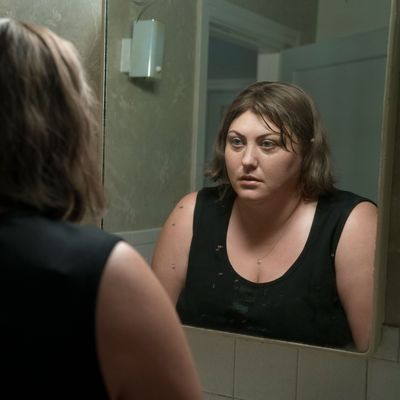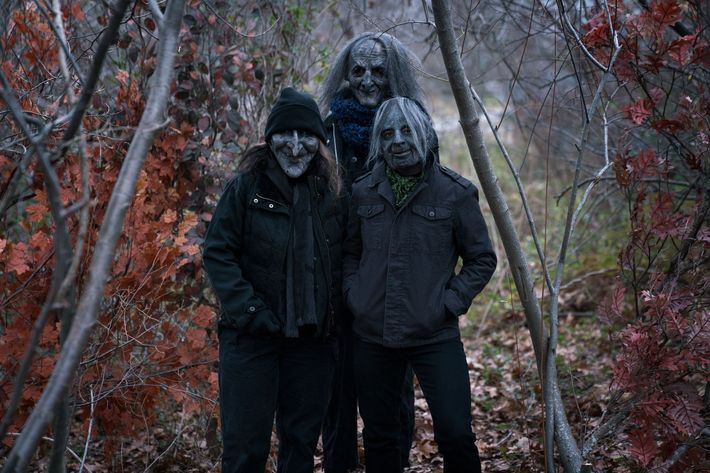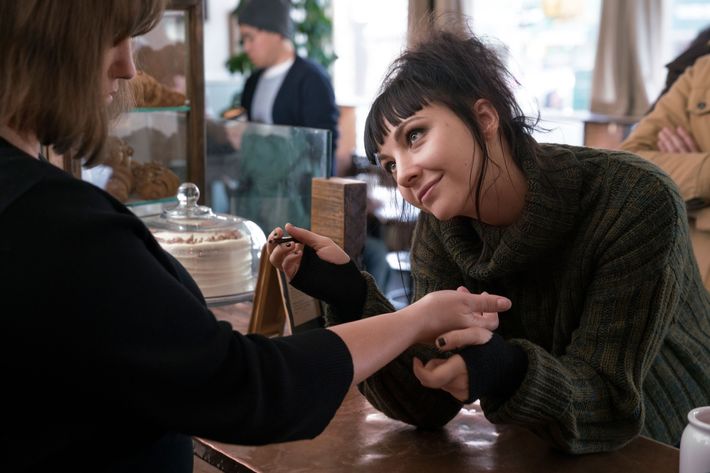
AMC’s Dietland, developed by Marti Noxon, follows Alicia “Plum” Kettle, a plus-sized woman who finds herself mixed up in a tangle of feminist revolutionaries, cutthroat fashion executives, and terrorists, all while going a journey of self-discovery. The show is broadly faithful to Sarai Walker’s 2015 novel, but it adds a few new characters and revamps plot elements in ways that make Dietland more workable as a serial story. Here are the biggest ways the show deviates from the book — with obvious spoilers for both.
Plum

The book: Plum rarely leaves her apartment except to go to meetings for her weight-loss program or to work at a café owned by her only friend Carmen, a pregnant lesbian. Though she worked at a restaurant as a teen, Plum rarely cooks anymore, afraid of being tempted by food. She’s also haunted by the memory of Janine, a woman who briefly came to a meeting of the Baptist diet plan with the intention of relieving some back pain before loudly denouncing the entire project as a “sick, self-loathing mindfuck.” After college, Plum worked at a small publisher for a few years before being hired as Kitty Montgomery’s ghostwriter.
The show: Plum bakes at the café for extra money, where Carmen has been replaced with Steven (Tramell Tillman), a gay man who owns the place and pesters Plum about her personal life. Where in the book Plum barely acknowledges people trying to draw her out of her shell, Steven and a couple of others in her orbit seem to be more interested in her life. The encounter with Janine — now Janice (Bethany Kay) — happens at a Waist Watchers meeting in the pilot, rather than during Plum’s childhood. Also, rather than working at the publisher, Plum went to grad school and got a Ph.D., eventually getting “kicked out” of academia.
Jennifer

The book: The murders committed by Jennifer happen largely in the margins of Walker’s book, during interlude chapters that abandon Plum’s perspective. Eventually, the police (and the other characters) realize that Jennifer is the Anglicized name of Soledad Ayala, the ex-military mother of Luz, a teen girl who committed suicide after being raped by several men. Though several characters theorized that Jennifer was a group, it is ultimately revealed to be a single, pissed-off person continuing to act as a soldier, albeit with the assistance of several other women, including her old Army buddies and Leeta. Most of the other women Plum interacts with aren’t involved in Jennifer and view it as vaguely distasteful.
The show: It’s too early to know whether Soledad Ayala will be introduced as a character in the AMC show, or if she’ll wind up being revealed as the mastermind behind Jennifer. But here, Jennifer is at the very least a much larger group of women: In the first episode, we’re introduced to the name “Jennifer” via a neck tattoo on a woman who huddles with a larger crew while they prepare to take revenge on some of their male victims. Several other characters are aware of Jennifer’s existence, and there are hints that a few of them are involved, including Cheryl Crane-Murphy (Rowena King), a television host who appears entirely through her show in the book, but here works with Kitty at Austen. Also, Plum watches several news reports that appear to allude to Luz’s rape and suicide, including the disappearance of two ex-military men who might be connected to Soledad.
Kitty

The book: Kitty is an almost entirely villainous presence in the book. She’s vain, not very smart, and deeply condescending toward Plum, whom she eventually fires. Rumors fly around the Austen Media offices that Kitty is secretly a lesbian, but they’re never confirmed.
The show: You can’t cast Julianna Margulies on your show and not have her be a more multidimensional, engaging character! The show spends more time with Kitty in the first few episodes than the book does, and makes an effort to give the audience a bit of Kitty’s perspective as an editor for the Austen Media women’s magazines, which she characterizes as her family. Kitty is still domineering and callous — and she’s still got fiery red hair — but she also cracks a bit under the pressures of maintaining her role as the idealized woman even as she ages. (In one scene, she’s furious at having been spotted eating; in another, she commiserates with another middle-aged woman over the struggles of maintaining her youthful appearance.) Although Kitty is still suspicious of Plum, she’s also aware of the fact that Plum dislikes and in some respects looks down on her, acknowledging that she pays Plum to make her sound smart and empathetic: “Who’s the fool in that equation?”
Plum’s love life

The book: Plum has never been in a romantic relationship; the closest she came was a friend in college who seemed to have feelings for her, but ultimately abandoned her. The antidepressant she takes has reduced her sex drive to the point where she only masturbates a couple of times a year, and she has an estranged relationship from her own body. Julia is attracted to Plum, but Plum doesn’t seem to reciprocate. Though she goes on a few blind dates with shallow men, she is happily single (or maybe “dating herself”) at the end of the book.
The show: Dominic (Adam Rothenberg), an NYPD detective who’s investigating hacks at Austen Media, is set up as a potential romantic interest for Plum, especially after he takes an interest in her baking. (He’s an original character with no analog in the book.) There are a few other possible seeds for romantic plots for Plum: Ben (Will Seefried), a sweet, goofy guy who works at the café, seems to be lightly enamored with her, and Julia’s interest in her is telegraphed much earlier. Also, during a hallucinogenic withdrawal from antidepressants, Plum viscerally rediscovers her sex drive and the appeal of her body.
Leeta

The book: Leeta spies for Julia as part of her plan to take down Austen Media, but also takes a substantial interest in Plum. They only interact three times: once when Plum asks Leeta if she’s following her (she is), once when Leeta tells Plum to pick up a copy of Verena’s book Adventures in Dietland, and once at the very end of the book, when Leeta is about to go on the run to escape punishment for her role in helping kick-start Jennifer.
The show: Leeta (Erin Darke) forms more of a relationship with Plum, trying to convince her that she’s not a scary stalker several times in the early episodes. Leeta also goes out of her way to set up a meeting between Verena Baptist and Plum, more explicitly than she does in the book, though it’s hard to say whether the show will follow the book in separating the two characters for most of the story.
Verena and Marlowe
The book: Verena Baptist, the daughter of weight-loss guru and fraud Eulayla Baptist, operates the feminist collective Calliope House. After being introduced to Plum, she brings her into the Calliope House fold, but doesn’t interact much with Plum’s other confidants such as Julia and Leeta. Her friend Marlowe Buchanan is a former sitcom star turned mom, activist, and writer of the book Fuckability Theory, assigned to give Plum a makeover. She has a tattoo that prominently displays a quote from a studio executive when she was fired from her show for putting on weight.
The show: Calliope House originally appears to be a nice house that hosts dinner parties — with male guests — and Marlowe (Alanna Ubach) still looks like a TV star, but she’s a few years older.

